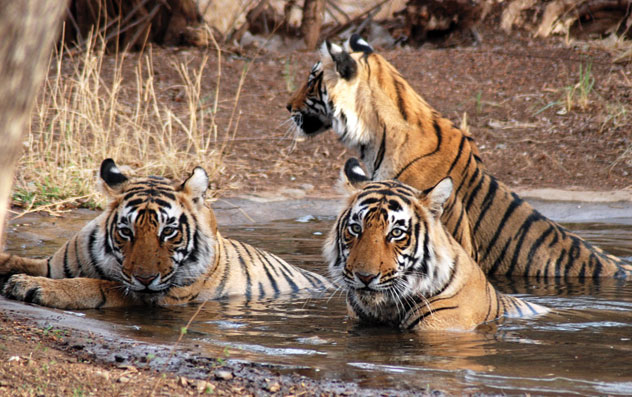WILDLIFE:
Protecting Wild Cats: Shooting Humans, Saving Tigers
The Maharashtra government recently issued shoot at sight orders. The purpose was not to put an end to a murderous communal riot or against terrorists on the loose. The license to kill order was against poachers in the state who have driven the Royal Bengal Tiger, the most magnificent animal on earth, to near extinction across India, writes Siddharth Srivastava.

(Above): A Royal Bengal tiger splashes water while sprinting at the Ranthambhor National Park in Rajasthan, India.
Over the last few weeks, two tigers and three leopards have been found killed in Maharashtra’s four tiger reserves. The government said it has received intelligence inputs that poachers have been given a contract to kill 25 tigers in the state. “The death caused by preventive shooting will not be treated as offence under the Indian Penal Code. We have made a legal provision to safeguard our staff from any excesses by so-called human right activists,” Maharashtra’s forest minister Patangrao Kadam said.
Sometimes drastic situations can only call equally if not more drastic measures. The shoot order highlights the desperate situation and follows a similar measure in Assam that is fighting to save the one-horned rhino, another severely threatened species. Thankfully, the rhino population has made a comeback, a bit of the success attributed to the strong arm tactics.
The tiger continues to be endangered. Today, not more than 1,500 tigers remain in the wild in India in highly protected pockets in Uttaranchal, Maharashtra, Madhya Pradesh, West Bengal, Rajasthan and Tamil Nadu. The beast is under severe threat of being exterminated due to human greed.
Tiger parts are valued more than gold, an already very expensive commodity, in the international market for medicinal properties, aphrodisiac and other superstitious beliefs. In the past, thousands of tigers in India have been hunted down for sport by erstwhile Maharajas, the rich and the British who ruled India. Today, killing a tiger is illegal and invites stiff penalties.
Still, not a week goes by without reports of tiger carcasses found under mysterious circumstances that raises concern -- valuable body parts chopped off, poisoned or trapped in poachers’ snares that result in the poor animal slowly bleeding to death. According to the Wildlife Protection Society of India, 14 tigers have been killed by poachers in India so far this year, already one more than entire 2011. An Alarmed National Tiger Conservation Authority (NTCA) last week asked forest departments to treat every death of big cat as case of poaching, unless proved otherwise.
On a recent visit to the Ranthambhor National Park in Rajasthan, where the endangered tiger population thankfully thrives, this writer found that the survival of India’s big cats will depend on sustenance of a complex eco-system that needs support at multiple levels.

(Above): The Royal Bengal tigers at the Ranthambhor National Park in Rajasthan, India.
There is immense pressure from various lobbies to encroach forestland – the mining mafia, the timber smugglers and the high income earning dairy farmers that need feed their cattle. In many instances, political bosses and authorities set up to protect forests, are prone to give in to the lure of the easy money in exchange of the illegal activities.
The presence of the tiger in a designated reserve area creates pressure to protect the animal and the associated biodiversity due to the national and international spotlight on the big cat.
Thus, saving the tiger is crucially linked to the existence and proliferation forests, green cover and inter-linked corridors that engenders healthy gene pools. It ensures the survival of the slightly less glamorous but equally important wildlife such as deer, wild buffaloes, crocodiles, elephants, varieties of birds and more. Support of local populations that have survived on the forest land for centuries is equally important. They form a critical cog in efforts to save the tiger.
No amount of funds, forest guards or technology can save the tiger if the people who reside inside and in the vicinity of the forests find themselves sidelined due to efforts to protect the big cat. Such has been the case at the Sariska sanctuary that adjoins Ranthambhor, where the tiger population was reduced to zero. A part of the blame rests on villagers associated with the very lucrative dairy industry in the area.
Prized cattle were under threat due to the presence of the tiger. The farmers feared that they would be deprived of their forest rights if the tiger numbers swelled in the area. Poachers, always on the lookout for such local angst, managed to easily infiltrate the Sariska forest and kill the tigers. By the time the happenings leaked to the larger world, it was already too late.
Tiger conservationists say that it is always difficult for poachers to operate if the locals see self-interest in the presence of the tiger. This can be possible by ensuring livelihoods linked to the associated tiger tourism industry, adequate compensation for loss of forest rights, relief and rehabilitation and employment opportunities.
There is still a long way to go before the Indian tiger can roar freely again. Hopefully, it is not already too late.
|